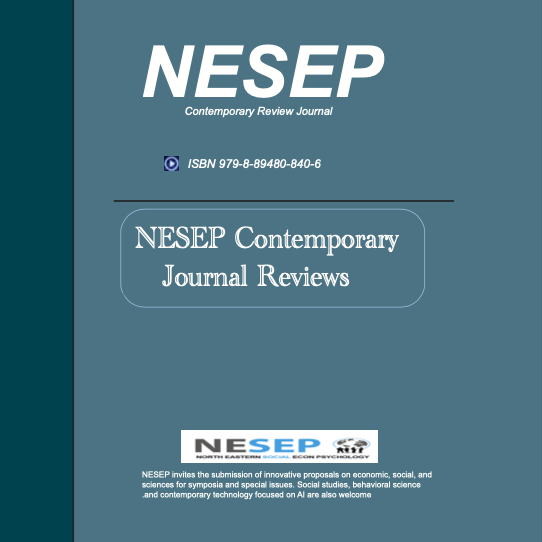Featured Issues
Below are compilations of selected work related to a contemporary matter area.

Palma, Spain. 6/30~7/2, 2025.
ISBN 2: 979-8-89480-848-2
Annual Conference
Publisher: NESEP
An Analysis of Eating Disorders in Young Adult Literature
Abstract: This paper sought to analyze the portrayal of eating
disorders in four works of Young Adult fiction. Previous research
suggests that the media—primarily magazines, television, and
film—have negatively and inaccurately depicted disordered eating.
For instance, characters in the situational comedy “Starved” were
often belittled by medical professionals for their eating disorders.
Such poor portrayals deliver incongruent messages to
impressionable audiences; perpetuated stereotypes may even
encourage some to mimic these behaviors. However, a gap in the
literature reveals itself, as no study has been conducted to assess
these portrayals through fiction. Therefore, using literature
analyses, key components of characterization, plot & setting,
diction & tone, relationships, and themes/messages were analyzed
in each novel. The true obsessive nature of eating disorders was
revealed, and authors often portrayed the protagonists to be wholly
consumed by their eating disorder. Additionally, the relationships
the characters maintained—whether they be familial, platonic, or
romantic—were pivotal to the development of their illnesses.
Keywords: Eating disorder, illness, medical professionals, media, behaviors affected by the disorder
References
[1] Agosto, Denise, Hughes-Hassel, Sandra, and Catherine Gilmore-
Clough. “The All-White World of Middle-School Genre Fiction:
Surveying the Field for Multicultural Protagonists.” Children’s
Literature in Education, vol. 35, no. 4, 2003, pp. 257-275. doi:
10.1023/B:CLID.0000004894.29271.bb
[2] Anderson, Laurie H. Wintergirls. Viking, 2009.
[3] Ballard, Alexandra. What I Lost. Square Fish, 2019.
[4] Block, Francesca L. The Hanged Man. Harper Teen, 1994.
[5] Boyd, Ashley, and Taylor Bereiter. “‘I Don’t Really Know What a
Fair Portrayal Is and What a Stereotype Is’: Pluralizing Transgender
Narratives with Young Adult Literature.” The English Journal, vol.
107, no. 1, 2017, pp. 13-18. http://www.jstor.org/stable/26359512
[6] Day, Katy, and Tammy Keys. “Starving in Cyberspace: A Discourse
Analysis of Pro-Eating Disorder Websites.” Journal of Gender
Studies, vol. 17, 2008, pp. 1-15. doi: 10.1080/09589230701838321
[7] Dell’Osso, Liliana et al. “Historical Evolution of the Concept of
Anorexia Nervosa and Relationships with Orthorexia Nervosa,
Autism, and Obsessive-Compulsive Spectrum.” Neuropsychiatric
Disease and Treatment, vol. 12, 2016, pp. 1651-1660.
doi:10.2147/NDT.S108912
[8] Ernst, Stefanie. “Using Qualitative Content Analysis of Popular
Literature for Uncovering Long-Term Social Processes: The Case of
gender relations in Germany.” Historical Social Research, vol. 34, no.
1, 2009, pp. 252-269. doi: 10.12759/hsr.34.3009.1.252-269
[9] Haart, Miriam. “Eating Disorders: As Seen on TV. An Analysis of
Eating Disorder Representation in the Media.” 2020.
https://www.researchgate.net/publication/346700710_Eating_Disorder
s_As_Seen_On_TV_An_Analysis_of_Eating_Disorder_Representatio
n_in_the_Media
[10] Katterman, Shawn, and Kelly Klump. “Stigmatization of Eating
Disorders: A Controlled Study of the Effects of the Television Show
Starved.” The Journal of Treatment and Prevention, vol. 18, no. 2,
2010, pp. 153-164. doi:10.1080/10640260903585599
[11] Kalodner, Cynthia. “Media Influences on Male and Female Non-
Eating-Disordered College Students: A Significant Issue.” The
Journal of Treatment and Prevention, vol. 5, no. 1, 2007, pp. 45-57.
doi: 10.1080/10640269708249203
[12] Kay, Paul. “Semantic Fields and Lexical Structure.” Linguistic Society
of America, vol. 53, no. 2, 1977, pp. 469-474.
doi: 10.1353/lan.1977.0012
[13] Kreipe, Richard, et al. “Eating disorders in adolescents: Principles of
diagnosis and treatment.” Pediatrics & Child Health, vol. 3, no. 3,
1998, pp. 189-192. doi: 10.1093/pch/3.3.189
[14] Levenkron, Steven. The Best Little Girl in the World. Grand Central
Publishing, 1981.
[15] Levitt, Heidi. “A semiotic understanding of eating disorders: The
impact of media portrayal.” Eating Disorders, vol. 5, no. 3, 1997, pp.
169-183. doi: 10.1080/10640269708249223
[16] Love, Jeannine, and Charity Fox. “Social Dreaming for Social Justice:
Power and Resistance in Chaos Walking.” Public Integrity, vol. 23,
2021, pp. 296-309. doi: 10.1080/1099
[17] Martin, Annika. “‘STICK A TOOTHBRUSH DOWN YOUR
THROAT:’ An Analysis of the Potential Liability of Pro-Eating
Disorder Websites.” Texas Journal of Women & the Law, vol. 14,
2005, pp. 151-178.
https://web.p.ebscohost.com/ehost/pdfviewer/pdfviewer?vid=6&sid=2
8b0bb7b-8b1c-4f95-980e-c340e3b13e87%40redis
[18] Mento, Carmela, et al. “Psychological Impact of Pro-Anorexia and
Pro-Eating Disorder Websites on Adolescent Females: A Systematic
Review.” International Journal of Environmental Research and
Public Health, vol. 18, 2021, pp. 2186-2199. Doi:
10.3390/ijerph18042186
[19] Meyers, Elizabeth. “Eating disorders: A Recollection and a Review of
Some Relevant Young Adult Fiction.” ALAN, vol. 25, no. 3, 1998.
doi: 10.21061/alan.v25i3.a.8
[20] Mohammad, Saif, and Peter Turney. “Emotions Evoked by Common
Words and Phrases: Using Mechanical Turk to Create an Emotion
Lexicon.” Proceedings of the NAACL HLT 2010 Workshop on
Computational Approaches to Analysis and Generation of Emotion in
Text, Association for Computational Linguistics, 2010, pp. 26-34,
https://aclanthology.org/W10-0204
[21] Mohammad, Saif. “From Once Upon a Time to Happily Ever After:
Tracking Emotions in Novels and Fairy Tales.” Decision Support
Systems, vol. 53, no. 4, 2012, pp. 105-114.
doi:10.1016/j.dss.2012.05.030
[22] Nalisnick, Eric, and Baird. “Character-to-Character Sentiment
Analysis in Shakespeare’s Plays.” Proceedings of the 51st Annual
Meeting of the Association for Computational Linguistics,
Association for Computational Linguistics, 2013, pp. 479-483,
https://aclanthology.org/P13-2085
[23] Patton, et al. “Onset of adolescent eating disorders: Population based
cohort study over 3 years.” BMJ, vol. 318, 1999, pp. 765-768. doi:
10.1136/bmj.318.7186.765
[24] Shroff, Hemal, and Thompson. “Body Image and Eating Disturbance
in India: Media and Interpersonal Influences.” The International
Journal of Eating Disorders, vol. 35, 2004, pp. 198-203. doi:
10.1002/eat.10229
[25] Thompson, Kevin, and Heinberg. “The Media’s Influence on Body
Image Disturbance and Eating Disorders: We’ve Reviled Them, Now
Can We Rehabilitate Them?” Journal of Social Issues, vol. 55, 1999,
pp. 339-353. doi: 10.1111/0022-4537.00119
[26] Vaismoradi, Mojtaba, et al. “Content Analysis and Thematic Analysis:
Implications for Conducting a Qualitative Descriptive Study.” Nursing
and Health Sciences, vol. 15, 2013, pp. 398-405. doi:
10.1111/nhs.12048
[27] Verma, Arushi, and Avgoulas. “Eating Disorders: Perceptions of
Young Women and Social Media Portrayal.” International Journal of
Health, Wellness, & Society, vol. 5, 2015, pp. 97-105. doi:
10.18848/2156-8960/CGP/v05i04/41146
[28] Whitaker, A.H. “An Epidemiological Study of Anorectic and Bulimic
Symptoms in Adolescent Girls: Implications for Pediatricians.”
Pediatric Ann., vol, 21, no. 11, 1992, pp. 752-759. doi: 10.3928/0090-
4481-19821101-10
[29] Writing Center. Pacific Lutheran University,
https://www.plu.edu/writingcenter/literature-analysis/ . Accessed 27
November 2021.